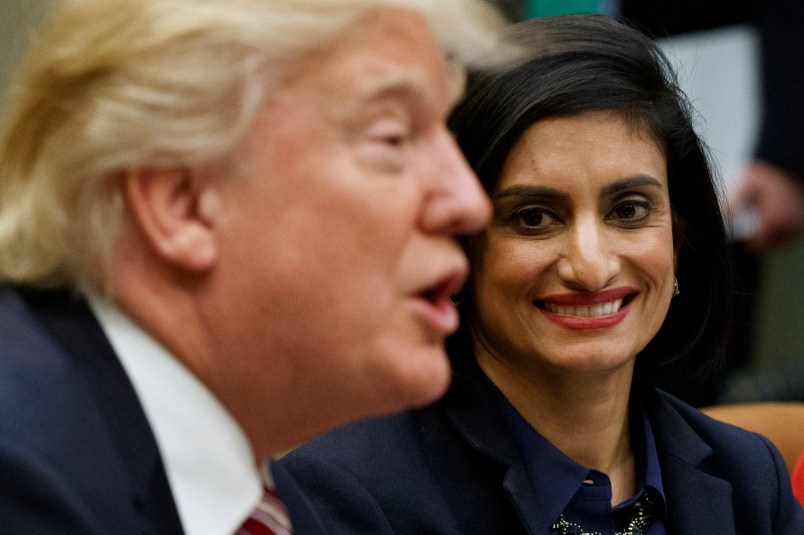On Tuesday morning, the Department of Health and Human Services (HHS) unveiled new criteria for evaluating pitches from states to tweak their Medicaid programs, a significant departure from the Obama administration’s approach to such requests.
Whereas in the past states had to prove that proposed changes would “increase and strengthen” health coverage of their low-income population, that requirement is gone, replaced with language that welcomes proposals for work requirements, drug tests and other hurdles that experts predict would reduce the Medicaid rolls by hundreds of thousands of people.
In a statement distributed to reporters Tuesday morning, Centers for Medicare & Medicaid Services (CMS) Administrator Seema Verma called the goal of covering more people a “hollow victory of numbers,” and instead called for changes that “reduce federal regulatory burdens, increase efficiency, and promote transparency and accountability.”
The announcement also promises to fast-track approval of states’ proposed Medicaid changes (which HHS grants in the form of waivers from existing Medicaid requirements) and to scrap some of the requirements that states report back to the federal government whether the changes improve health outcomes for recipients.
One of the biggest changes Verma signaled Tuesday was a rule change allowing states to impose work requirements on their Medicaid recipients and kick people out of the program who cannot find gainful employment.
“Every American deserves the dignity and respect of high expectations and as public officials we should deliver programs that instill hope and say to each beneficiary that we believe in their potential,” Verma said. “CMS believes that meaningful work is essential to beneficiaries’ economic self-sufficiency, self-esteem, well-being, and health of Americans.”
Several states have already submitted requests to CMS to impose work requirements on their Medicaid programs, and Tuesday’s announcement is expected to open the floodgates to many more. The Obama administration had flatly denied such requests, arguing that they do not serve the purpose of Medicaid.
“I’m not sure how denying coverage for people based on their inability to find work really meets the objective of providing health insurance to low-income individuals,” said Jessica Schubel, a senior advisor for CMS during the Obama administration.
Health law experts previously told TPM that there could be legal challenges if CMS moves forward with approving state Medicaid waivers for work requirements, on the basis that the policy is “not consistent with goals of Medicaid,” and imposes an undue burden on low-income people struggling to find employment.
A 2017 study by the Kaiser Family Foundation found that only 27 percent of Medicaid recipients are adults without disabilities, and 60 percent of that group are already working. Most of those not employed are either caring for a family member full-time, have a criminal record, live in an area without job opportunities, or face other “major impediments” to employment.
HHS’ new criteria for the Medicaid waivers is as follows:
- Improve access to high-quality, person-centered services that produce positive health outcomes for individuals;
- Promote efficiencies that ensure Medicaid’s sustainability for beneficiaries over the long term;
- Support coordinated strategies to address certain health determinants that promote upward mobility, greater independence, and improved quality of life among individuals;
- Strengthen beneficiary engagement in their personal healthcare plan, including incentive structures that promote responsible decision-making;
- Enhance alignment between Medicaid policies and commercial health insurance products to facilitate smoother beneficiary transition; and
- Advance innovative delivery system and payment models to strengthen provider network capacity and drive greater value for Medicaid.
The criteria under the Obama administration, however, was quite different:
- increase and strengthen overall coverage of low-income individuals in the state;
- increase access to, stabilize, and strengthen providers and provider networks available to serve Medicaid and low-income populations in the state;
- improve health outcomes for Medicaid and other low-income populations in the state; or
- increase the efficiency and quality of care for Medicaid and other low-income populations through initiatives to transform service delivery networks.







More scroogification of the safety net.
Heartless.Bastard.
Like all GOP’ers.
“Are there no workhouses?!”
Drug testing companies are right up there with private prison operators in the GOP’s heart.
So when next year rolls around that 60% that are working and on the Medicaid rolls will be told that they must meet X amount of hours worked, and that could mean at your current job or hey go out and get a 2nd job.